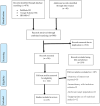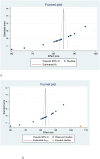Level of adherence to option B+ program and associated factors among HIV-positive women in Ethiopia: A systematic review and meta-analysis
- PMID: 38662634
- PMCID: PMC11045077
- DOI: 10.1371/journal.pone.0298119
Level of adherence to option B+ program and associated factors among HIV-positive women in Ethiopia: A systematic review and meta-analysis
Abstract
Background: Despite policy initiatives and strategic measures highly focused on preventing mother-to-child transmission through the implementation of the Option B+ program, adherence to the treatment is still challenging. The level of adherence and determinants of Option B+ program utilization reported by different studies were highly inconsistent in Ethiopia. Hence, this systematic review and meta-analysis aimed to estimate the pooled prevalence of adherence to the Option B+ program and its predictors among HIV-positive women in Ethiopia.
Methods: PubMed, Google Scholar, EMBASE, HINAR, Scopus, and Web of Sciences were searched for published articles from March 2010 to March 2022. The pooled prevalence of adherence was estimated using a weighted DerSimonian-Laird random effect model. The I2 statistics was used to identify the degree of heterogeneity. Publication bias was also assessed using the funnel plot and Egger's regression test.
Results: A total of 15 studies were included. The pooled estimate of the option B+ program among HIV-positive women in Ethiopia was 81.58% (95% CI: 77.33-85.84). Getting social and financial support (AOR = 3.73, 95% CI: 2.12, 6.58), disclosure of HIV status to partners (AOR = 2.05, 95% CI: 1.75, 2.41), time to reach a health facility (AOR = 0.33, 95% CI: 0.16, 0.67), receiving counseling on drug side effects (AOR = 4.09, 95% CI: 2.74, 6.11), experience of drug side effects (AOR = 0.17, 95% CI: 0.08, 0.36), and knowledge (AOR = 4.73, 95% CI: 2.62, 8.51) were significantly associated with adherence to the Option B+ program.
Conclusion: This meta-analysis showed that the level of adherence to the Option B+ program in Ethiopia is lower than the 95% level of adherence planned to be achieved in 2020. Social and financial support, disclosure of HIV status, time to reach the health facility, counseling, drug side effects, and knowledge of PMTCT were significantly associated with option B+ adherence. The findings of this meta-analysis highlight that governmental, non-governmental, and other stakeholders need to design an effective strategy to scale up the level of disclosing one's own HIV status, access health facilities, improve knowledge of PMTCT, and counsel the potential side effects of Option B+ drugs, and advocate the program to reduce the multidimensional burden of HIV/AIDS.
Trial registration: Prospero registration: CRD42022320947. https://www.crd.york.ac.uk/prospero/display_record.php?ID=CRD42022320947.
Copyright: © 2024 Ayele et al. This is an open access article distributed under the terms of the Creative Commons Attribution License, which permits unrestricted use, distribution, and reproduction in any medium, provided the original author and source are credited.
Conflict of interest statement
The authors have declared that no competing interests exist.
Figures




Similar articles
-
Magnitude and risk factors of mother-to-child transmission of HIV among HIV-exposed infants after Option B+ implementation in Ethiopia: a systematic review and meta-analysis.AIDS Res Ther. 2024 Jun 7;21(1):39. doi: 10.1186/s12981-024-00623-6. AIDS Res Ther. 2024. PMID: 38849895 Free PMC article.
-
Adherence to option B+ and its association with disclosure status and counseling among HIV-positive pregnant and lactating women in Ethiopia: systematic review and meta-analysis.Public Health. 2022 Oct;211:105-113. doi: 10.1016/j.puhe.2022.07.016. Epub 2022 Sep 1. Public Health. 2022. PMID: 36058198
-
A systematic review and meta-analysis of vertical transmission route of HIV in Ethiopia.BMC Infect Dis. 2018 Jun 22;18(1):283. doi: 10.1186/s12879-018-3189-3. BMC Infect Dis. 2018. PMID: 29929480 Free PMC article.
-
Level of adherence to option B plus PMTCT and associated factors among HIV positive pregnant and lactating women in public health facilities of Hawassa city, Southern Ethiopia.PLoS One. 2021 Aug 5;16(8):e0255808. doi: 10.1371/journal.pone.0255808. eCollection 2021. PLoS One. 2021. PMID: 34352020 Free PMC article.
-
The magnitude of adherence to option B plus program and associated factors among women in eastern African countries: a systematic review and meta-analysis.BMC Public Health. 2020 Nov 27;20(1):1812. doi: 10.1186/s12889-020-09903-y. BMC Public Health. 2020. PMID: 33246437 Free PMC article.
References
-
- World Health Organization. Global guidance on criteria and processes for validation: elimination of mother-to-child transmission of HIV and syphilis. 2nd edition, ISBN 978-92-4-151327-2 World Health Organization, Geneva: 2017.
-
- WHO, UNICEF, UNAIDS, UNFPA. HIV transmission through breastfeeding: a review of available evidence an update from 2001 to 2007. Access 25/11/2020.
-
- World Health Organization. Progress report on the global plan towards the elimination of new HIV infections among children and keeping their mothers alive. Geneva, Switzerland: WHO, 2015.
-
- Wolrd Health Organization. PMTCT Strategic Vision 2010–2015: Preventing Mother-to-Child Transmission of HIV to Reach the UNGASS and Millennium Development Goals: Moving Towards the Elimination of Paediatric HIV, December 2009 (2010).
Publication types
MeSH terms
Substances
LinkOut - more resources
Full Text Sources
Medical

